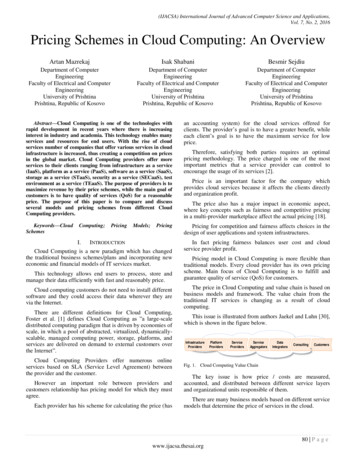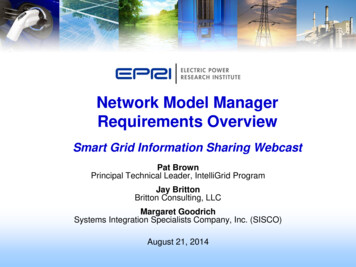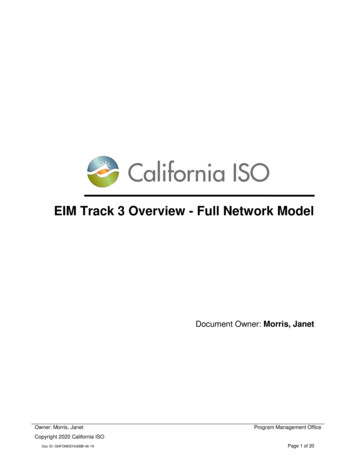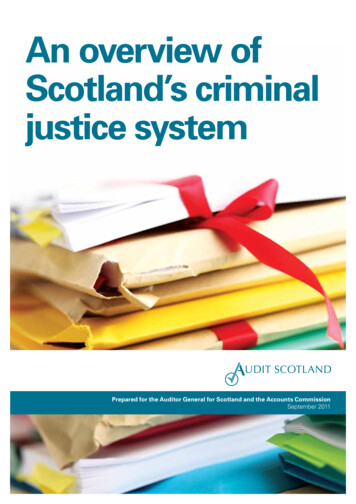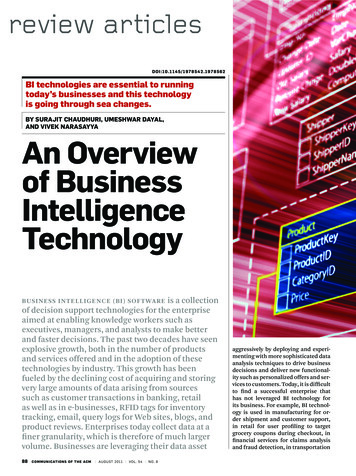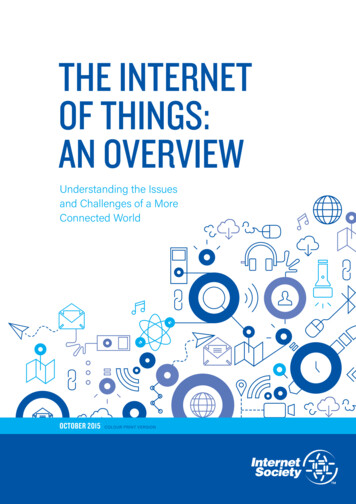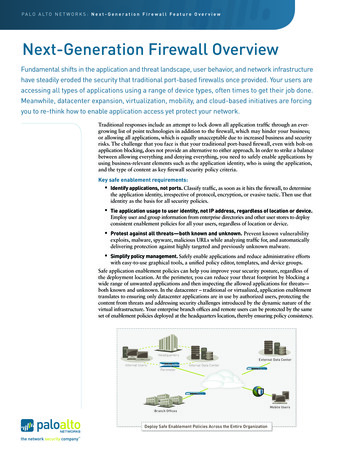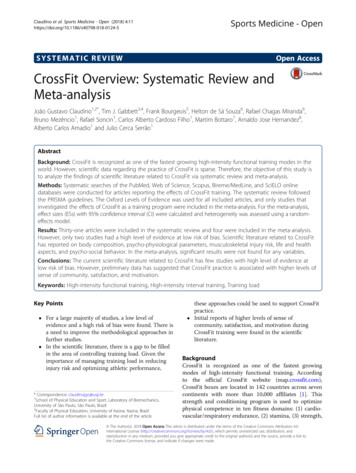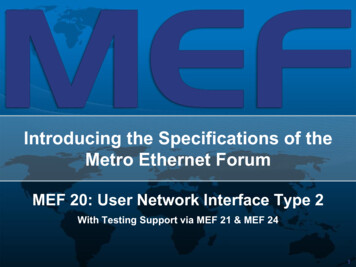
Transcription
Introducing the Specifications of theMetro Ethernet ForumMEF 20: User Network Interface Type 2With Testing Support via MEF 21 & MEF 241
Approved MEF SpecificationsMEF 2MEF 3MEF 4MEF 6.1MEF 7MEF 8MEF 9MEF 10.1MEF 11MEF 12MEF 13MEF 14MEF 15MEF 16MEF 17MEF 18MEF 19MEF 20MEF 21MEF 22MEF 23MEF 24*Requirements and Framework for Ethernet Service ProtectionCircuit Emulation Service Definitions, Framework and Requirements inMetro Ethernet NetworksMetro Ethernet Network Architecture Framework Part 1: Generic FrameworkMetro Ethernet Services Definitions Phase 2EMS-NMS Information ModelImplementation Agreement for the Emulation of PDH Circuitsover Metro Ethernet NetworksAbstract Test Suite for Ethernet Services at the UNIEthernet Services Attributes Phase 2*User Network Interface (UNI) Requirements and FrameworkMetro Ethernet Network Architecture FrameworkPart 2: Ethernet Services LayerUser Network Interface (UNI) Type 1 Implementation AgreementAbstract Test Suite for Traffic Management Phase 1Requirements for Management of Metro EthernetPhase 1 Network ElementsEthernet Local Management InterfaceService OAM Framework and RequirementsAbstract Test Suite for Circuit Emulation ServicesAbstract Test Suite for UNI Type 1User Network Interface (UNI) Type 2 Implementation AgreementAbstract Test Suite for UNI Type 2 Part 1: Link OAMMobile Backhaul Implementation Agreement Phase 1Class of Service Implementation Agreement Part 1Abstract Test Suite for UNI Type 2 Part 2: E-LMIMEF 10 .1 replaces and enhances MEF 10 Ethernet Services Definition Phase 1 and replaced MEF 1 and MEF 5.MEF 10.1.1 an amendment to MEF 10.1 has also been approved. MEF 6.1 replaced MEF 6.2
This PresentationPurpose:This presentation is an introduction to MEF 20AudienceEquipment Manufacturers building devices that will carry CarrierEthernet Services.Useful for Service Providers architecting their systemsOther DocumentsPresentations of the other specifications and an overview of allspecifications is available on the MEF web siteOther materials such as white papers and case studies are alsoavailable3
Introducing MEF 20The presentation coversMEF 20 OverviewFunctionality and scope of MEF 20UNI definition and architectureTechnical overviewMEF 20 technical detailsImplementation optionsKey QuestionsRelationship to other specifications and standardsImplementation Agreement structureComparison with legacy solutionsTesting MEF 20 (using MEF 21 & MEF 24)Summary4
MEF 20 UNI Type 2: Overview (In context of MEF 11)MEF 11 introduced 3 types of UNIUNI Type 1 (now defined in MEF 13), November 2005Service Provider and Customer manually configure the UNI-N and UNI-Cfor servicesUNI Type 1.1 and 1.2 are definedType 1.1 : Non-multiplexed UNI for Services like EPLType 1.2 : Multiplexed UNI for Services like EVPLUNI Type 2 (now defined in MEF 20)An automated implementation model allowing UNI-C to retrieve EVCstatus and configuration information from UNI-NEnhanced UNI attributesAdditional fault management and protection functionalityBackward compatibility with UNI Type 1UNI Type 3 (Possible future MEF Specification)Allows the UNI-C to request, signal and negotiate EVCs and itsassociated Service Attributes to the UNI-N. UNIType 3 is for further study.5
Functionality and Scope of MEF 20Ethernet Local Management Interface (E-LMI)Allows UNI-C to retrieve EVC status and service attributes fromUNI-N as specified in MEF 16Link OAM (Operation, Administration and Management)Allows customer and service provider to monitor and diagnosethe UNI connectivity via Link OAM (link level)Service OAMAllows customer and service provider to monitor and diagnosethe UNI connectivity via Service OAM (end-to-end)ProtectionCapability to protect UNI against port failure via Link AggregationprotocolEnhanced UNI AttributesSuch as bandwidth profile per egress UNI, Maximum Transfer Unitsize, etc. as defined in MEF 10., MEF 6.1L2CP HandlingGoverns the passing or filtering of Layer 2 control protocols to theEthernet Virtual ConnectionsDetails of each mandatory and optional element are to be found in the specification6
MEF 20 Enhances Carrier Ethernet AttributesBrings Carrier Ethernet to a new level byenabling new functionality to Carrier Ethernetattributes of scalability, service management,reliability, QoS and standardized services7
MEF 20 Advances Carrier Ethernet DeploymentCarrier Ethernet growth challengesThe success of Carrier Ethernet brings its own challenges, not theleast of these is operational scalabilityUntil now, MEF specifications have defined manual managementprocess relying on manual or ad hoc processes. This cannot scale.MEF 20Introduces automated processes for managing services,fault monitoring and management enabling at UNI levelCarrier Ethernet networks to scaleCarrier Ethernet networks to operate at reduce cost andCreation of a framework for the dynamic service provisioning that willleverage the inherent benefits of MEF-defined Carrier Ethernet services8
MEF Specifications OverviewMEF 20PurposeAudienceUser Network Interface (UNI) Type 2 Implementation AgreementSpecifies MEF UNI characteristics and operation in which customer sideof the UNI is automatically configured by the network side of the UNIallowing verification of SLA and UNI connectivity. Additional objectivesinclude support for Ethernet OAM (802.3ah, 802.1ag) over the UNI.Required for support of ELMIEquipment Manufacturers building devices that will carry Carrier EthernetServices. Useful for Service Providers architecting their systems.Technical Committee Architecture AreaMEF 21/24Abstract Test Suite for UNI Type 2, Phase 1: Link OAMPurposeProvides the first of six possible test suites for UNI type 2 (MEF 20)AudienceEquipment Manufacturers building devices that will carry Carrier EthernetServices. Useful for Service Providers architecting their systems.Technical Committee Test and Measurement Area9
UNI Definitions10
UNI DefinitionsBackgroundThe User Network Interface in the MEF Specificationsis an abstract concept. On one side of this point theservice provider has responsibility and on the other,the customer.As such, it appears in diagrams in various positions inboth in the MEF Specifications and in presentationsThis can be the source of confusionPurpose and AudienceFor readers of the technical specifications andpresentations, this short presentation provides clarity11
Functionality and Scope of MEF 20Ethernet Local Management Interface (E-LMI)Allows UNI-C to retrieve EVC status and service attributes from UNI-Nas specified in MEF 16Link OAM (Operation, Administration and Management)Allows customer and service provider to monitor and diagnose the UNIconnectivity via Link OAM (link level)Service OAMAllows customer and service provider to monitor and diagnose the UNIconnectivity via Service OAM (end-to-end)ProtectionCapability to protect UNI against port failure via Link AggregationprotocolEnhanced UNI AttributesSuch as bandwidth profile per egress UNI, Maximum Transfer Unitsize, etc. as defined in MEF 10., MEF 6.1L2CP HandlingGoverns the passing or filtering of Layer 2 control protocols to theEthernet Virtual ConnectionsDetails of each mandatory and optional element are to be found in the specification12
The MEF User Network InterfaceThe User Network Interface (UNI)The UNI is the single point that is the demarcationbetween the customer and the service provider/CableOperator/Carrier/MSOThe UNI is typically at a port on an active device ownedand operated by the Service ProviderThe UNI in a Carrier Ethernet Network uses a physicalEthernet Interface at operating speeds 10Mbs,100Mbps, 1Gbps or 10GbpsCECarrier EthernetNetworkcustomerresponsibilityUNIService providerresponsibilityCE: Customer Equipment, UNI: User Network Interface.In this instance the UNI islocated at the port of theservice provider edge devicelocated in the customerpremises.The service providerclo d is sho n ermina ingin the customer premisesMEF certified Carrier Ethernet products13
Functional Elements of the UNI (1)There are two functional elements (typically*) locatedin two connected devices situated on either side ofthe UNI demarcation point:UNI-C: Executes the processes of the customer sideUNI-N: Executes the processes of the network side* All the functions of the UNI-N and UNI-C need not be located in thesame physical device as they may be located in several devicesUNI-CCECarrier ce providerresponsibilityCE: Customer Equipment, UNI: User Network Interface.MEF certified Carrier Ethernet products14
UNI-C and UNI-N Functional Elements (2)Relationship between service frames (user generated), control andCarrier Ethernet management framesS bscriber o S bscriber ser ice frames (incl ding S bscriber s da a,control and management frames) are handled by UNI-C and UNI-Ndata plane functional elementsControl frames between Subscriber and Service Provider are handledby UNI-C and UNI-N control plane functional elementsManagement frames between Subscriber and Service Provider arehandled by UNI-C and UNI-N managementEMSplanefunctional elementsInterfaceManagementManagement planeplaneDataDataplaneplaneETH Access ane planeControlControl planeplaneUNI-CETH TrunkLinksDataDataplaneplaneUNI-NService Frame FlowUNI ReferencePoint15
How the UNI is shown in MEF Technical SpecificationsDiagrams in the Specifications show the UNI in various positions.All three are valid but the first is by far the most likely to be seen in an operational network1. At the port of the service provider equipment(The usual position in the customerpremises or multi-tenant location)2. A hef he cme e i me(Less typical although in theory the Service providersedge device need not be on the customer emisesEquipmentService Provider CarrierEthernet NetworkService Provider CarrierEthernet NetworkUNI3. In the middle of the wire betweenCustomer and Service Provider(This is only an abstract view)CustomerPremisesEquipmentService Provider CarrierEthernet Network16
Carrier Ethernet ArchitectureThis slide shows the UNI in the context of other Carrier Ethernet architectural elementsCustomerSiteService Provider 1Service Provider NI-NUNIUser Network InterfaceUNI-C UNI-customer sideUNI-N UNI-network I-CNetwork to Network InterfaceExternal NNIInternal NNIThe UNI is the physical demarcation point between the responsibility of the ServiceProvider and the responsibility of the Subscriber.17
MEF 20 Technical Overview18
MEF 20 in the context of MEF 13MEF 13: UNI Type 1 Implementation AgreementApproved in November 2005UNI Type 1.1 and 1.2 are definedType 1.1 : Non-multiplexed UNI for Services like EPLType 1.2 : Multiplexed UNI for Services like EVPLS.P. and customer manually configure the UNI-N andUNI-C for servicesMEF 20 e e dhi19
Technical Details (1)Ethernet Local Management Interface (E-LMI)Allows UNI-C to retrieve EVC status and service attributes fromUNI-N as specified in MEF 16Link OAM (Operation, Administration and Management)Allows customer and service provider to monitor and diagnose theUNI connectivity via Link OAM (link level)Link OAM moni ors UNI s Ph sical La er opera ion and heal h andimproves fault isolation.Link OAM frames run between UNI-C and UNI-N.Service OAMAllows customer and service provider to monitor and diagnose theUNI connectivity via Service OAM (end-to-end)A small but useful, set of capabilities based on ITU-T Y.1731 andIEEE 802.1agFocused on fault management for the Maintenance Entity Groupscrossing the UNI for all service types. A Maintenance Entity (ME) isa point-to-point relationship between two Maintenance Entity Pointswithin a single Maintenance Entity Group20
Technical Details (2)ProtectionCapability to protect UNI against port failure via LinkAggregation protocol in various physical configurationsEnhanced UNI attributes introduced with MEF6.1 and MEF 10.1Bandwidth profile per UNI, per-EVC and per CoS IDegress bandwidth profiling of Committed Information RateMaximum Transfer Unit sizeHandling of E-Tree (rooted multipoint) servicesL2CP HandlingPass to EVCNot pass to EVC (Filter)21
MEF 20 Implementation OptionsMEF 20 Specifies phased/alternate implementation.This allows quicker time to market and faster time torevenue for all concernedUNI Type 2.1UNI Type 2.2Mandatory FeaturesMandatory FeaturesBackward comp. to UNI Type 1Service OAMEnhanced UNI attributesBackward comp. to UNI Type 1Service OAMEnhanced UNI attributesL2CP handlingL2CP handlingLink OAMProtectionOptional FeaturesLink OAMProtectionE-LMIE-LMI22
Relationship to Other MEF and Industry StandardsFunctionSourceMEF 20 Implementation Agreement is anenhancement to UNI Type 1MEF13Functionality includes capability for UNI-C toretrieve EVC status & configuration of serviceattributes from UNI-N via E-LMIMEF16Capability for customer and service provider toexamine UNI connectivity via Link OAMClause 57 of IEEE 802.3Capability for customer and service provider toexamine UNI connectivity via Service OAMITU-T Y.1731 andIEEE 802.1agCapability to protect UNI against port failure viaLink AggregationClause 43 of IEEE 802.3Why has the MEF undertaken the initiative?This e ac l in line i h he MEF s mission o nder ake ork ha helpsaccelerate the adoption of Carrier Ethernet and to use other existingstandards wherever practicalThe MEF maintains standing liaisons with these industry standards bodies23
Implementation Agreement StructureThe Implementation AgreementDefines those elements that must be presentand contains summaries of the conceptsreferred to in the previous slideUNI Type 2 Discovery & Configuration ensures theelements to be managed are presentThe remaining sections handle the features of 2.1and 2.2 optionsWhere appropriate, these sections describe eachfunction present in the referenced standards (e.g.Management Entity Groups) stating which aremandatory and optional24
How Does MEF 20 Compare with Legacy Solutions?ComparisonThe addition of UNI type 2 functionality is comparableto baseline functionality of other legacy technologiesHe eMEF 20 now enables the flexibility, servicegranularity and cost benefits of Carrier Ethernet notpresent in less flexible or lower bandwidth legacysolutions25
Brief introduction toAbstract Test Suite for UNI Type 2(MEF 21 & MEF 24)26
MEF 21/MEF 24: Testing UNI Type 2Work in Progress /possible projectsMEF 11User Network Interface (UNI)Requirements and Framework(April 2009)Abstract Test Suite for UNI Type 2Part 3: Service OAM(Letter Ballot)MEF 13MEF 20UNI Type 1Implementation AgreementUNI Type 2Implementation AgreementAbstract Test Suite for UNI Type 2Part 4: ProtectionMEF 19MEF 21Abstract Test Suite for UNI Type 2Part 5: Enhanced UNI AttributesAbstract Test Suite for UNIType 1Abstract Test Suite for UNIType 2 Part 1: Link OAMAbstract Test Suite for UNI Type 2Part 6: L2CP HandlingMEF 24Abstract Test Suite for UNI Type 2Part 2: E-LMI (Approved April 21st 2009)Further Test projects are in preparationE-NNI will leverage MEF 21 test casesMEF Certification will be decided in due courseE-NNI will leverage MEF 21 test casesMEF Certification will be decided in due course27
MEF 21 Part 1 ScopeCovers test procedures for Link OAM described in theUNI Type 2 IA & clause 57 of IEEE 802.3-2005An overview of the different groups of requirements that composeLink OAM is provided as follows:OAM Discovery process initiation and DTE reactionsInformation OAMPDU exchangeEvent Notification OAMPDU exchangeVariable Request & Response OAMPDU exchangeLoopback Control OAMPDU exchange and DTE reactionsOrganization Specific OAMPDU exchangeStructureTest Configurations for UNI-C and UNI N140 Test Procedures for Link OAM28
MEF 24 Part 2 ScopeCovers test procedures based on a combination ofrequirements for E-LMI described in MEF 20 UserNetwork Interface (UNI) Type 2 ImplementationAgreement and in MEF 16 Ethernet Local ManagementInterface.An overview of the different groups of requirements that composeE-LMI is provided as follows:E-LMI Framing MechanismsE-LMI MessagesE-LMI ProceduresE-LMI ImpairmentsStructureTest Configurations for UNI-C and E-LMI140 Test Procedures for UNI-N and E-LMI29
Final WordNext ActionsRead the detailed MEF 20 ImplementationAgreementReview MEF 21 and MEF 24 Abstract Test Suitesavailable on the MEF web site30
Accelerating Worldwide Adoption ofCarrier-class Ethernet Networks and Serviceswww.MetroEthernetForum.org31
2 MEF 2 Requirements and Framework for Ethernet Service Protection MEF 3 Circuit Emulation Service Definitions, Framework and Requirements in Metro Ethernet Networks MEF 4 Metro Ethernet Network Architecture Framework Part 1: Generic Framework MEF 6.1 Metro Ethernet Services Definitions Phase 2 MEF 7 EMS-NMS Information Mo


